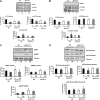Placental glucose and amino acid transport in calorie-restricted wild-type and Glut3 null heterozygous mice
- PMID: 22700768
- PMCID: PMC3404359
- DOI: 10.1210/en.2011-1973
Placental glucose and amino acid transport in calorie-restricted wild-type and Glut3 null heterozygous mice
Abstract
Calorie restriction (CR) decreased placenta and fetal weights in wild-type (wt) and glucose transporter (Glut) 3 heterozygous null (glut3(+/-)) mice. Because placental nutrient transport is a primary energy determinant of placentofetal growth, we examined key transport systems. Maternal CR reduced intra- and transplacental glucose and leucine transport but enhanced system A amino acid transport in wt mice. These transport perturbations were accompanied by reduced placental Glut3 and leucine amino acid transporter (LAT) family member 2, no change in Glut1 and LAT family member 1, but increased sodium coupled neutral amino acid transporter (SNAT) and SNAT2 expression. We also noted decreased total and active phosphorylated forms of mammalian target of rapamycin, which is the intracellular nutrient sensor, the downstream total P70S6 kinase, and pS6 ribosomal protein with no change in total and phosphorylated 4E-binding protein 1. To determine the role of placental Glut3 in mediating CR-induced placental transport changes, we next investigated the effect of gestational CR in glut3(+/-) mice. In glut3(+/-) mice, a key role of placental Glut3 in mediating transplacental and intraplacental glucose transport was established. In addition, reduced Glut3 results in a compensatory increase of leucine and system A transplacental transport. On the other hand, diminished Glut3-mediated intraplacental glucose transport reduced leucine transport and mammalian target of rapamycin and preserved LAT and enhancing SNAT. CR in glut3(+/-) mice further reduced transplacental glucose transport and enhanced system A amino acid transport, although the increased leucine transport was lost. In addition, increased Glut3 was seen and preserved Glut1, LAT, and SNAT. These placental changes collectively protect survival of wt and glut3(+/-) fetuses against maternal CR-imposed reduction of macromolecular nutrients.
Figures





Similar articles
-
Neurodevelopment Is Dependent on Maternal Diet: Placenta and Brain Glucose Transporters GLUT1 and GLUT3.Nutrients. 2024 Jul 21;16(14):2363. doi: 10.3390/nu16142363. Nutrients. 2024. PMID: 39064806 Free PMC article. Review.
-
Maternal Calorie Restriction Causing Uteroplacental Insufficiency Differentially Affects Mammalian Placental Glucose and Leucine Transport Molecular Mechanisms.Endocrinology. 2016 Oct;157(10):4041-4054. doi: 10.1210/en.2016-1259. Epub 2016 Aug 5. Endocrinology. 2016. PMID: 27494059 Free PMC article.
-
High-fat diet affects pregestational adiposity and glucose tolerance perturbing gestational placental macronutrient transporters culminating in an obese offspring in wild-type and glucose transporter isoform 3 heterozygous null mice.J Nutr Biochem. 2018 Dec;62:192-201. doi: 10.1016/j.jnutbio.2018.09.001. Epub 2018 Sep 13. J Nutr Biochem. 2018. PMID: 30308381 Free PMC article.
-
Prenatal caloric restriction enhances DNA methylation and MeCP2 recruitment with reduced murine placental glucose transporter isoform 3 expression.J Nutr Biochem. 2014 Feb;25(2):259-66. doi: 10.1016/j.jnutbio.2013.10.015. Epub 2013 Nov 22. J Nutr Biochem. 2014. PMID: 24445052 Free PMC article.
-
Glucose transporters in the human placenta.Placenta. 2000 Jan;21(1):14-22. doi: 10.1053/plac.1999.0448. Placenta. 2000. PMID: 10692246 Review.
Cited by
-
Neurodevelopment Is Dependent on Maternal Diet: Placenta and Brain Glucose Transporters GLUT1 and GLUT3.Nutrients. 2024 Jul 21;16(14):2363. doi: 10.3390/nu16142363. Nutrients. 2024. PMID: 39064806 Free PMC article. Review.
-
RISING STARS: Mechanistic insights into maternal-fetal cross talk and islet beta-cell development.J Endocrinol. 2023 Nov 8;259(3):e230069. doi: 10.1530/JOE-23-0069. Print 2023 Dec 1. J Endocrinol. 2023. PMID: 37855321 Free PMC article. Review.
-
Placental Responses to Changes in the Maternal Environment Determine Fetal Growth.Front Physiol. 2016 Jan 29;7:12. doi: 10.3389/fphys.2016.00012. eCollection 2016. Front Physiol. 2016. PMID: 26858656 Free PMC article. Review.
-
Pregnancy Metabolic Adaptation and Changes in Placental Metabolism in Preeclampsia.Geburtshilfe Frauenheilkd. 2024 Sep 19;84(11):1033-1042. doi: 10.1055/a-2403-4855. eCollection 2024 Nov. Geburtshilfe Frauenheilkd. 2024. PMID: 39524034 Free PMC article.
-
Developing Brain Glucose Transporters, Serotonin, Serotonin Transporter, and Oxytocin Receptor Expression in Response to Early-Life Hypocaloric and Hypercaloric Dietary, and Air Pollutant Exposures.Dev Neurosci. 2021;43(1):27-42. doi: 10.1159/000514709. Epub 2021 Mar 26. Dev Neurosci. 2021. PMID: 33774619 Free PMC article.
References
-
- Barker DJ. 1995. The Wellcome Foundation Lecture. The fetal origins of adult disease. Proc Biol Sci 262:37–43 - PubMed
-
- Barker DJ. 2007. The origins of the developmental origins theory. J Intern Med 261:412–417 - PubMed
-
- Fowden AL, Forhead AJ, Coan PM, Burton GJ. 2008. The placenta and intrauterine programming. J Neuroendocrinol 20:439–450 - PubMed
-
- Jansson T, Powell TL. 2006. IEPA 2005 Award in Placentology Lecture. Human placental transport in altered fetal growth: does the placenta function as a nutrient sensor? Placenta 27(Suppl A):S91–S97.5 - PubMed
-
- Sadiq HF, Das UG, Tracy TF, Devaskar SU. 1999. Intra-uterine growth restriction differentially regulates perinatal brain and skeletal muscle glucose transporters. Brain Res 823:96–103 - PubMed
Publication types
MeSH terms
Substances
Grants and funding
LinkOut - more resources
Full Text Sources
Molecular Biology Databases
Research Materials
Miscellaneous

